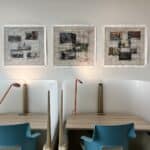by elin o’Hara slavick
From Citric Acid, An Online Orange County Literary Arts Quarterly of Imagination and Reimagination, Issue 9, March 2024
VIRAL INTEGRATION, the inaugural group art exhibition in the Susan & Henry Samueli College of Health Sciences Hall and Sue & Bill Gross Nursing and Health Sciences Hall, University of California, Irvine includes over one hundred works by forty artists from across the country and Canada - all addressing health issues. VIRAL INTEGRATION is curated by Artist-in-Residence elin o’Hara slavick. The exhibition can be viewed on all five floors of the building, primarily in the lobby areas. The Susan & Henry Samueli College of Health Sciences Hall and Sue & Bill Gross Nursing and Health Sciences Hall 856 Health Sciences Road, University of California, Irvine, California. Free and open to the public, Monday – Friday, 8-5pm. The exhibition runs until December 15, 2024.

Art is a creative act, not a destructive one. Art is a form and practice of resistance – resistance against death and grief, loss and mourning, disease and discomfort, patriarchal and imperial systems, narrow definitions, invisibility, and annihilation, and against dull ways of being human. Viral Integration showcases work that addresses health issues – from AIDS, COVID, mental health and birth to coal ash ponds, lung transplants, migraines, and surgery. In each instance there is a refusal to resign to the status quo.
Heidi Kumao transforms a brace for a broken back into funny characters, utilizing humor as a subversive tool, while simultaneously performing the solitary struggle of surviving, existing, floating, freezing, healing, being. This is a self-portrait on an iceberg by Kumao, “two years of medical trauma summed up in one image. This is not photoshopped. I packed a hospital gown.”
Allison Strauss resists the dominant narrative by inscribing a calligraphic COVID lexicon in brown ink on a Doom Scroll. Subtracting virtual and now colloquial doom scrolling language from the illuminated and constantly feeding screen of information, Strauss inscribes our newly acquired language into an old school primer, an automatic poem, a list of collective utterances.
About her piece, Strauss writes: “Handwritten in Blackletter calligraphy, Doom Scroll is an alphabetical record of references to specific events and vocabulary that entered the general lexicon during Covid. Doom Scroll is about the intersection of public health and social history. The public had a crash course in epidemiology, picking up such terms as contact tracing, herd immunityand species barrier. A new contagion-related language was also generated: contactless, distance learning, double masking, elbow bump, frontline worker.”

Andrew Johnson resists reality by depicting it carefully, in the long shadow of Goya – images of humans masking to survive while trying to sweep the germs (and injustice, genocide, poverty, greed, racism) away and men in full protective suits ushering out a contaminated couch of luxury and privilege.
“The clocks differ; the time now.
The geography varies; the chamber here.The light unstable, flat, or harsh.
The air is stifling and noxious.
The trunk open; the chair empty.
The desk deserted; the lessons left.
The consequences dire.
The gesture is ever wanton, remeasured.
Our first responder, giver of care
least recognized, and last to leave.
Until, at a moment’s notice,
the dust settles.”
“The ghost of patriarchy is going away, reclining and ensconced
in high culture – as is his want.
He absently gestures to no one in particular.
The sovereign sway of cherubs and camels give way
to another sanitized history: our own.
First responders in bleached personal protective equipment
take their haul to the burial trench.”
Jeremiah Johnson startles us out of complacency with his skull made up of prescription pills and vitamins.
This skull, installed near the Samueli College of Health Sciences actual pharmacy, represents Johnson’s struggle with the inadequate American healthcare system that involves unregulated and soaring pricing, exorbitant medical expenses and living with an uncurable and debilitating disease that prevents one from earning money to pay for care. His struggle is not only his own, but the struggle of many who are ignored and continue to die from lack of care.
To end on a more hopeful note, Sally Ann McKinsey explores the act and practice of care in her work. This enormous round quilt is made of emergency department thermal blankets, hospital gowns, socks, and operating room sheets. Hanging, it becomes a memorial, inviting viewers to see the knots that hold it together and to consider the process of its making. Transforming hospital textiles that hold, dress, and tend to the ill body into surprising tactile art works, McKinsey attempts to comfort the suffering, to warm up the cold clinical space.
The exhibition is vast and inclusive, offering respite and protest. Admission free but purchase of UC Irvine parking pass definitely required. Go see it: VIRAL INTEGRATION!

Artists: Becca Albee, Adrian Baker, Megan Bent, Suzanne Broughel, Frances Bukovsky, Lena Chen, Raphaële Cohen-Bacry, Robert Del Tredici, Lauren Evans, Luke Firle, Julie Harrison, Katie Hartley, Nancy Jo Haselbacher, Abby Hepner, Juanita Holley, Anneka Huegerich, Jesse Jackson, Michele Jaquis, Andrew Ellis Johnson, Jeremiah Johnson, Heidi Kumao, Margaret Lazzari, Sam Marroquin, Jocelyn Mathewes, Penny Mateer and Martha Wasik, Sally Ann McKinsey, Allyson Mellberg Taylor, Sarana Mehra, Lorie Novak, Dominic Quagliozzi, Caroline Rutledge Armijo, Cheri Sampson, Sarah Slavick, Susanne Slavick, Allison Strauss, Noriho Uriu, Amy White, Frederick Wright Jones, Tessa Windt, and Natalie Yu
elin o'Hara Slavick is the Artist-in-Residence in the College of Health Sciences at the University of California, Irvine. She was the 2022 Huntington Art and Research Fellow at Caltech in 2022. Her work is in the collections of the Queens Museum, National Library of France, Library of Congress, Nasher Museum of Art and the Art Institute of Chicago. She was represented by Cohen Gallery in LA. Slavick is the author of Bomb After Bomb: A Violent Cartography and After Hiroshima. She has held artist residencies in Canada, France, the U.S. and Japan. Her work has been featured in The New York Times, Los Angeles Times, FOAM, Asia-Pacific Journal, and Actuphoto: Actualite Photographique, among others.




